June 21, 2025 | 02:25 GMT +7
June 21, 2025 | 02:25 GMT +7
Hotline: 0913.378.918
June 21, 2025 | 02:25 GMT +7
Hotline: 0913.378.918
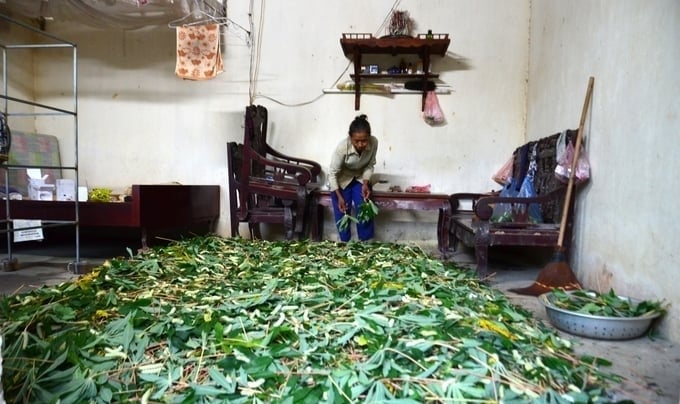
Raising cassava silkworms on a house floor in Dong Luong commune, Cam Khe district, Phu Tho province. Photo: Duong Dinh Tuong.
Dr. Le Hong Van, Director of the Central Mulberry Research Center, analyzed that the reason is that raising silkworms on the ground requires a separate breeding house, a large area, and tough conditions in the area, but the plain is crowded with people.
When piloting the model in traditional Northern houses with an altar placed in the middle and two rooms on both sides, people had to remove all furniture, such as beds, cabinets, tables, and chairs, to make room for raising silkworms. In contrast, people were gathered together in one room or under the extra house.
Later, raising silkworms on the floor made things simpler. No longer having to pick up ripe silkworms, but when they were evenly ripe, put them in a bed and then just put them in the middle so they could crawl up independently.
Also, because silkworms were raised in houses in the past, it was impossible to disinfect them. Now, they are raised in private houses, so they are fully disinfected like pigs raised in industrial-style barns. In addition to disinfection, farmers also sprinkle white lime on the silkworm bodies every day to both disinfect and dry the farming area. In addition, there are currently many effective medicines to prevent diseases for silkworms.
Regarding strawberry varieties, before 1970, it was an indigenous variety, with a yield of only 12-15 tons of leaves/ha. From 1970 to 1993, we selected to create triploids, yielding 25 tons/ha. Since 1993, we have developed hybrid mulberry, yielding 30 - 35 tons/ha. Currently, new strawberry varieties account for over 90%.
Regarding silkworms, previously, there were silkworms with yellow cocoons, fragile shells, then hybrid yellow cocoons, and then two systems of white cocoons. Starting in 1993, the Mulberry Silk Corporation encountered a recession, and the silkworm breeding system gradually staggered.
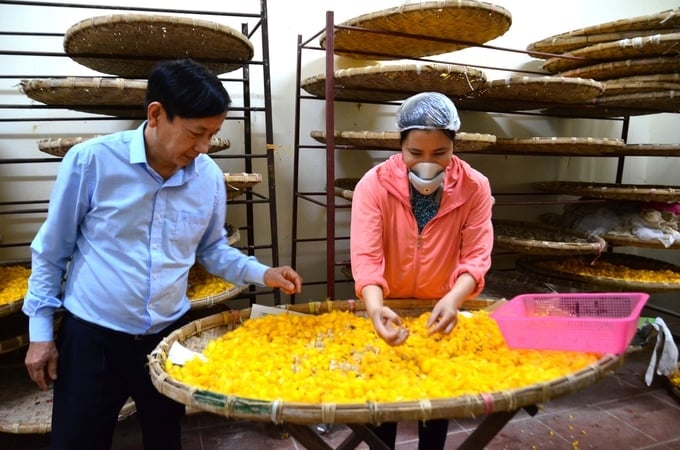
Dr. Le Hong Van (left) is checking the cocoon quality. Photo: Duong Dinh Tuong.
By 2012, the mulberry growing area in Vietnam stopped decreasing and began to increase, currently reaching 13,938 hectares, double the lowest period but not half of the peak period. However, cocoon output is now more than 16,824 tons, no less than the peak period.
Vietnam's silk output 2021 reached 1,067 tons, ranking 4th in the world, exporting USD 72 million, after China, India, and Uzbekistan, even higher than the most glorious period in the 90s.
In the world, while other countries are still declining in the mulberry area, only a few countries have returned to development. Vietnam has increased the rankings the fastest, and Thailand, which previously had many mulberry areas, has not yet overcome the decline.
Regarding silk reeling technology, before manual and mechanical reeling factories, most have now changed to automatic reeling. With much higher labor productivity, silk quality has improved very clearly. Previously it was only level E and level G, now it has widely reached level 2A.
According to Dr. Le Hong Van, Director of the Central Mulberry Research Center, in the past, raising silkworms was mainly for silk production, but now it is multi-purpose. Silkworms are very resistant to chemicals, and so are the mulberry leaves they eat. They do not have to use any pesticides. The input is clean, the output is a safe food, suitable for future food trends including nutrient-rich insects.
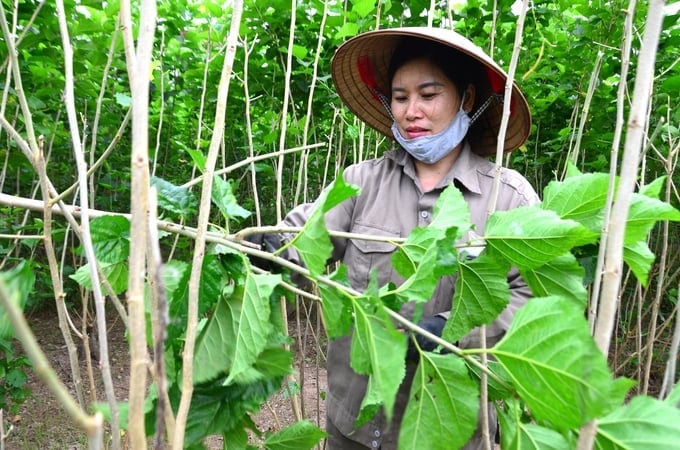
Picking mulberries to raise silkworms. Photo: Duong Dinh Tuong.
Originating from a period of market fluctuations where silk could not be consumed, farmers had to sell ripe silkworms or cut cocoons to sell pupae. In Vietnam, a market for raising silkworms and selling pupae has gradually formed in traditional silkworm farming areas.
If mulberry is a separate crop, the area can be counted, and from there, the yield of silkworms and silk can be inferred; then cassava is a root crop; only in some places are the leaves used to raise a special type of silkworm and cassava, so it is impossible to estimate the output. The yield of cassava silkworms can only be calculated through the number of eggs.
Raising silkworms and cassava is a symbiotic economy when the silkworm farmer does not have to grow mulberries or cassava but takes advantage of available cassava areas, exploiting less than 1/3 of the leaves daily so as not to affect the roots below.
It is typical of a self-sufficient economy, but it gradually shifts towards goods when ripe silkworms are brought to the market to be sold like other goods. The advantage of cassava silkworms is their strong resistance, making cooked silkworm food popular with people in the area.
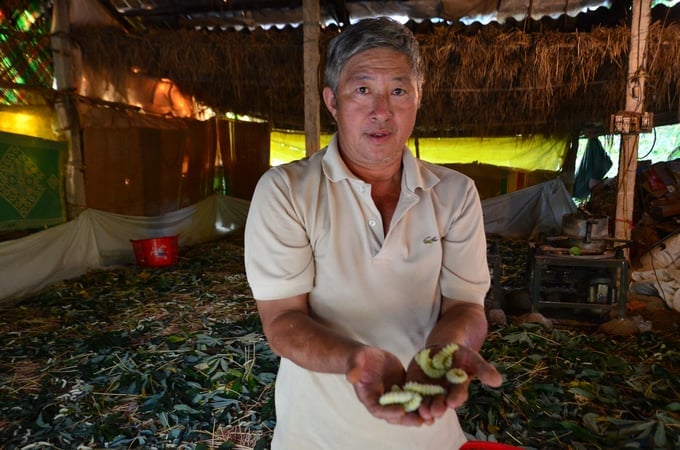
Raising silkworms and cassava for food in Dong Luong. Photo: Duong Dinh Tuong.
Since people converted to growing cassava for leaves to feed silkworms, the harvest is 200 million/ha per year, up to 10 times more. After the first year of picking leaves, people cut off the cassava stem, leaving the root to sprout to get more leaves. At the end of the second year, they dig up the tubers to sell as animal feed.
It is estimated that the whole commune currently has about 300 workers involved in raising silkworms for meat and seed cassava silkworms, providing most of the seeds for the entire North, bringing in annual revenue of up to VND 60 billion. Northern midland and mountainous provinces such as Yen Bai, Son La, Thanh Hoa... can all raise silkworms and cassava similar to Phu Tho.
Translated by Huong Giang
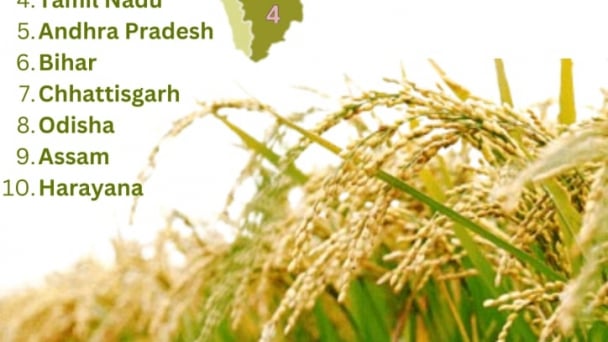
(VAN) Last week, the U.S. Department of Agriculture (USDA) released its June World Agricultural Supply and Demand Estimates (WASDE), raising projections for both Indian rice production and U.S. rice imports for the 2025/2026 marketing year.
/2025/06/17/2344-1-131758_261.jpg)
(VAN) Amid tariff risks and growing trade barriers in the U.S. market, Australia is emerging as a promising destination to sustain the growth momentum of Vietnam's shrimp exports.
/2025/06/17/2013-1-nongnghiep-112009.jpg)
(VAN) This notable growth trend reflects the global taste for fresh, nutritious fruits and the expanding use of lychees across various sectors.
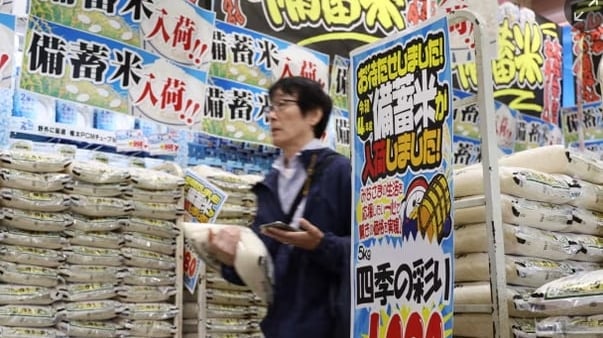
(VAN) The political and cultural insulation of Japan’s beloved grain is falling apart, and experts warn the country’s relationship with the staple will have to adapt.
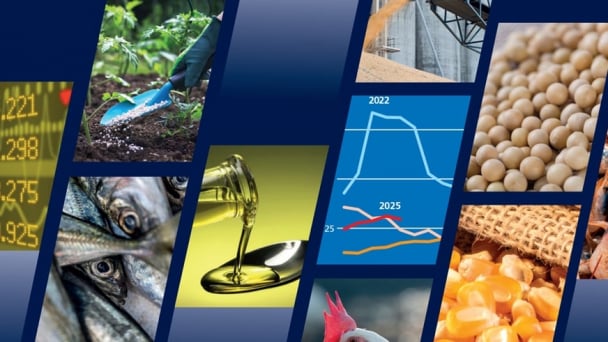
(VAN) Noting risks, report examines impacts of avian influenza, changing trade patterns since 2022, fish fraud, and shipping industry’s net-zero goals.

(VAN) Mr. Tran Quang Bao, General Director of the Forestry and Forest Protection Department, met and worked with the International Wood Products Association to promote cooperation in the field of timber trade.

(VAN) China's outbound shipments of rare earths in May jumped 23% on the month to their highest in a year, though Beijing's export curbs on some of the critical minerals halted some overseas sales.